
| Darin McQuoid | Blog | Reviews | Tutorials | River Directory |
Pursuit
of the 50
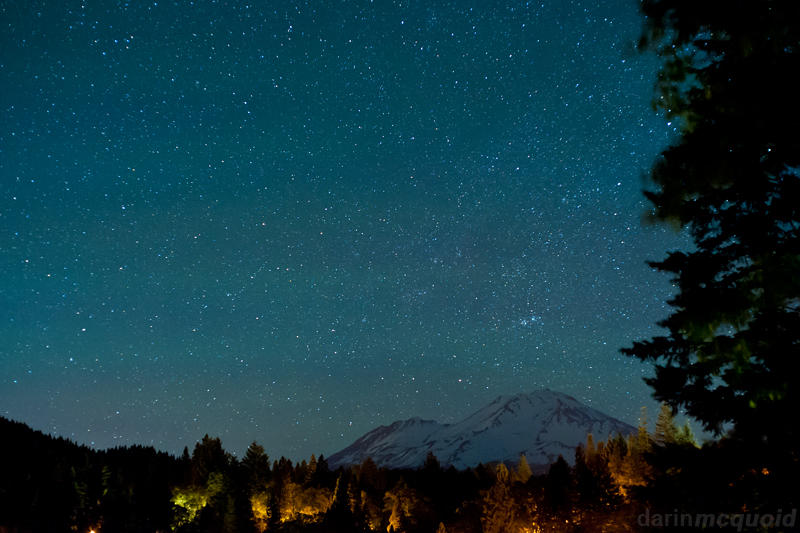

Nikon
D700, Nikkor
50mm F/2 AI @ 15" f/2.8 ISO 3200
The
short version is that in my experience, at night, wide open
or at f/2, the Sigma 50mm f/1.4 HSM has less coma
but is
not quite as sharp in the center vs the Nikkor 50mm f/1.2 AIS. At the
edge of the frame the Sigma has a slight lead in sharpness. Read on for
more if you like detail.
There
is a very
detailed review of many 50mm lenses here, but a fast 50mm
lens is
not for use in bright daylight.
In
the process of capturing the above image in 2011, the hunt began for an
ideal 50mm for shooting stars. The above image looks good online,
but in
full sized view
the image pretty soft, and the exposure was a bit too long at fifteen
seconds and the
stars leave small trails. Plus there is some noise because the
original was too dark and had to be pushed a full stop in
post-processing. In general, 50mm lenses are cheap to make, and have
been in production longer than SLR cameras. So there are plenty of
options out there. The obvious choice would be one designed
specifically
for night, Nikon's 58mm f/1.2 Noct-Nikkor, except for its $4,000 price
tag. I don't take that
many
night sky shots, or have that kind of disposable income. Just recently
I picked up the Nikkor 50mm f/1.2 AIS
and Sigma 50mm
f/1.4 HSM and got a chance to shoot them an a night sky.
A quick note on each lens. The Nikkor 50mm f/1.2 AIS is a manual focus lens that has been in production for over thirty years and retails at $700. It's beautifully built to the highest classic Nikkor quality and has a standard of the era 52mm filter size. It holds a reputation as Nikon's sharpest 50mm lens at f/2 and is currently their fastest lens in production. Like all fast lenses of its age, images have a "glow" wide open with notable loss of contrast. Although lighter than the Sigma at 13oz, the all metal build makes it feel like it could last forever. I picked mine up used in beautiful condition for $450.
The Sigma 50mm f/1.4 EX DG HSM is a new lens on the market retailing at $450. Build quality is standard for a modern high end Sigma, it's nice but doesn't offer anywhere near the tactile and visual appeal of the old Nikkor. It's also heavier at 18oz and uses a 77mm front filter. The large filter size might be an issue for people new to photography, but it is the standard for all high end Nikkor f/2.8 zooms, which in reality makes filter sharing more realistic than the Nikkor for most modern photographers. As you can guess the 77mm diameter makes the lens big, and this lens is well suited for a FX camera and will feel big on DX models. Sigma was obviously shooting for the higher end here when they produced this lens because at the time of release it was more expensive than any 50mm f/1.4 Nikkor, though now it's matched in price by the latest AF-S G version. It's also worth noting the Sigma is more of a 45mm than a true 50mm focal length.
Researching these two lenses I came across some interesting opinions. F-stops are just a mathematical equation of what the light transmission of a lens should be. T-stops are the actual measured transmission values. I saw many claims that the Sigma f/1.4 actually allowed in more light at f/1.4 than the Nikkor at f/1.2. According to some, the digital sensor does not react to light coming in at an angle as well as film, making fast lenses less fast in reality on a digital sensor. Also according to some, because of this problem, a digital camera will actually increase the ISO behind the scenes so that the old fast lenses expose and meter like they should. So that raises the question of how do we test the actual t-stop of a lens without complicated equipment? Simple enough in my case, try both lenses on the Sony NEX-7 because it will shoot with no idea what lens is attached and therefore has no reason to change the ISO. In tests on the NEX-7, the Nikkor 50mm f/1.2 shows an imperceptible difference between f/1.2 and f/1.4. At either aperture it lets in slightly more light at than the Sigma f/1.4 but has notably lower contrast. On the other hand, mounted on the D700 at night the Sigma f/1.4 produced brighter images, perhaps confirming the ISO boost behind the scenes theory, or just a different sensor to lens response. I'd also guess that with the 77mm front filter is has a lot less vignetting.
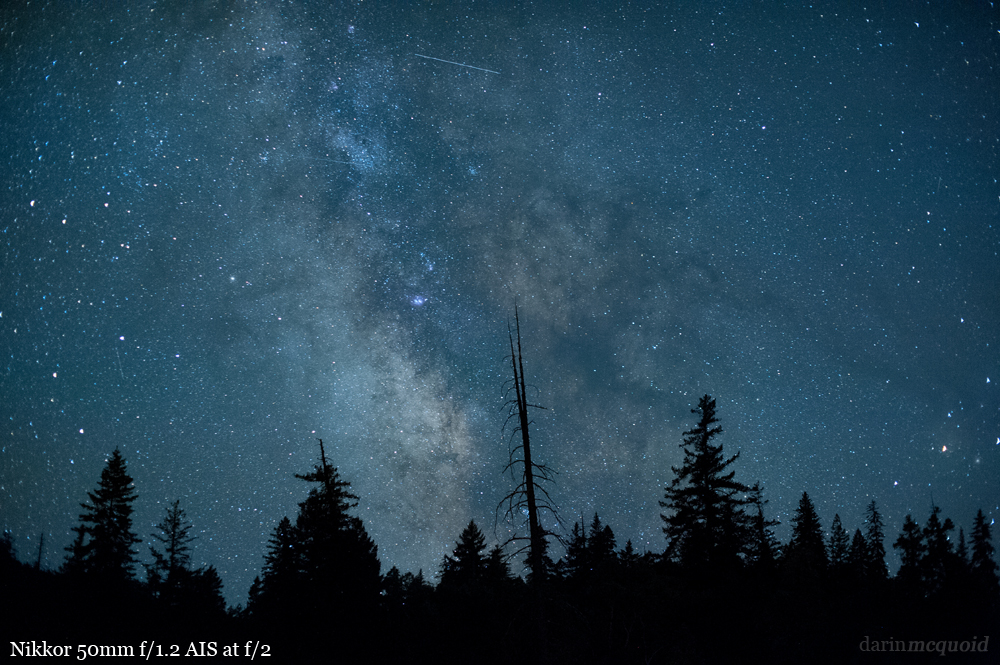
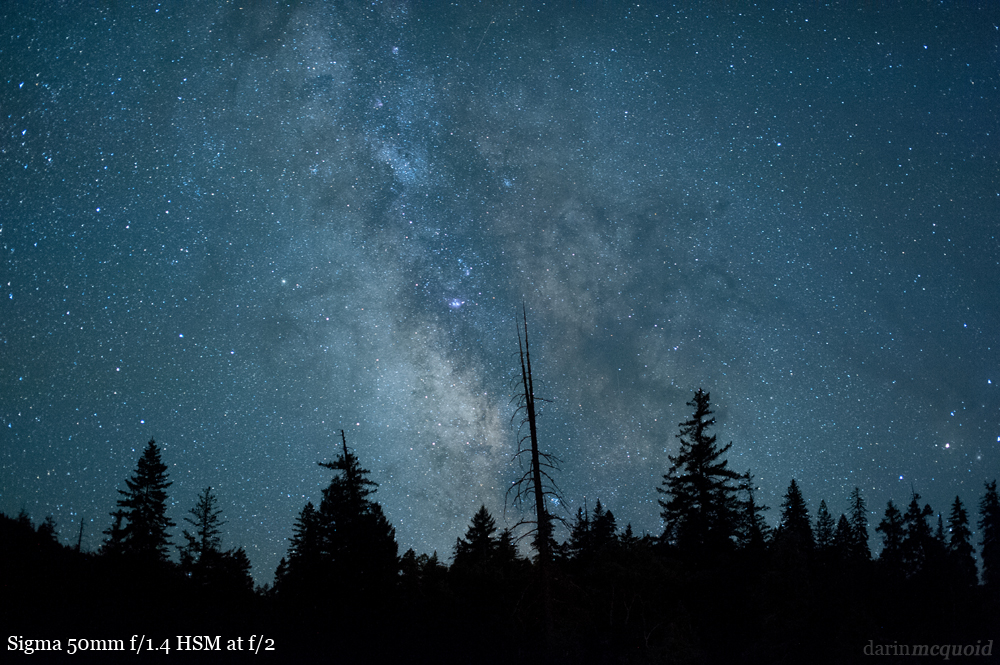
Let's get right to it, 100% crops from the center at f/1.4, ten second exposure at ISO 3200 on a Nikon D700
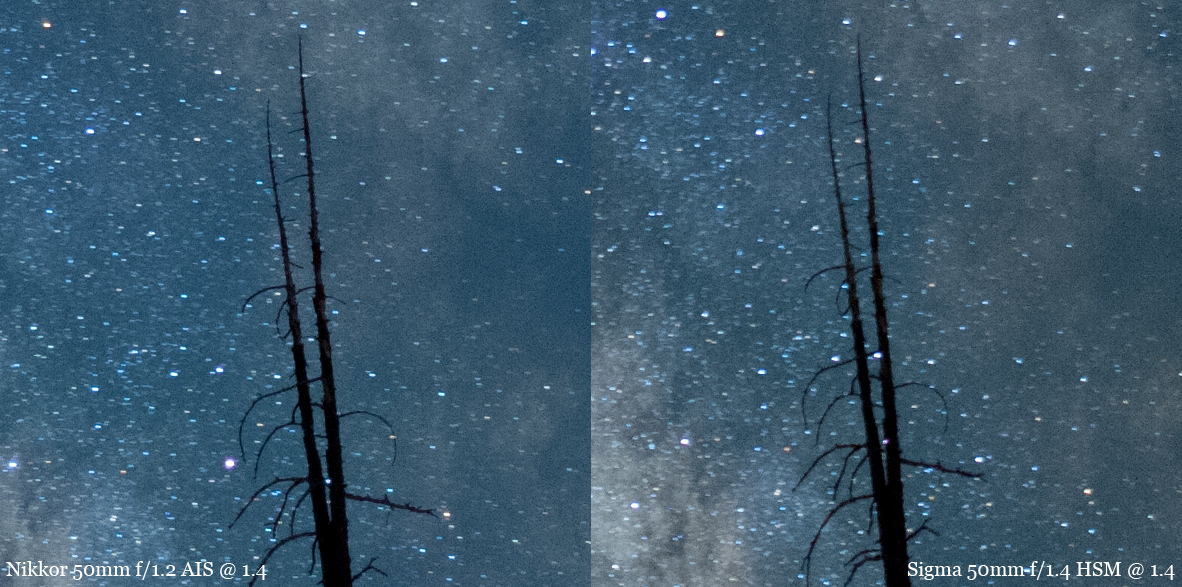
Crop from the right edge at at f/1.4

Centers at f/2, ten second exposure at ISO 6400 on a Nikon D700

Sides of the images at f/2
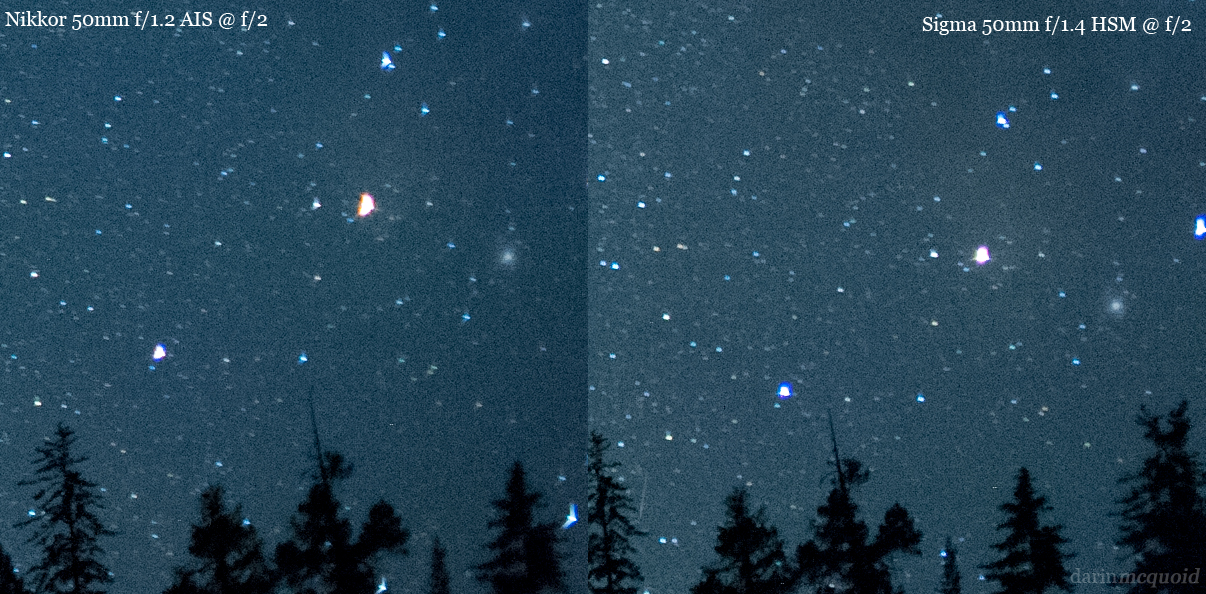
A larger size difference than performance would indicate.

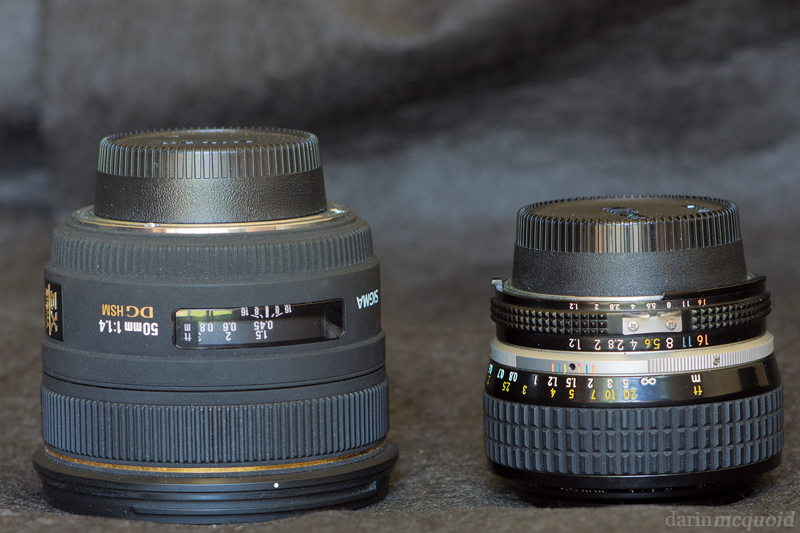
For the curious, yes the 50mm f/1.2 looks pretty bad wide open shooting stars. Even more coma than the 28mm f/2.
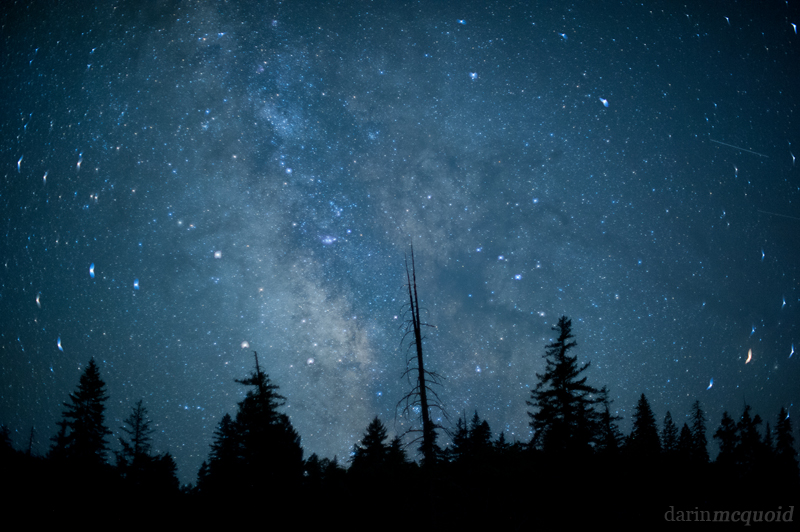
Nikon D700, Nikkor 50mm f/1.2 Ai-s @ 10" f/1.2 ISO 3200
2014 Update
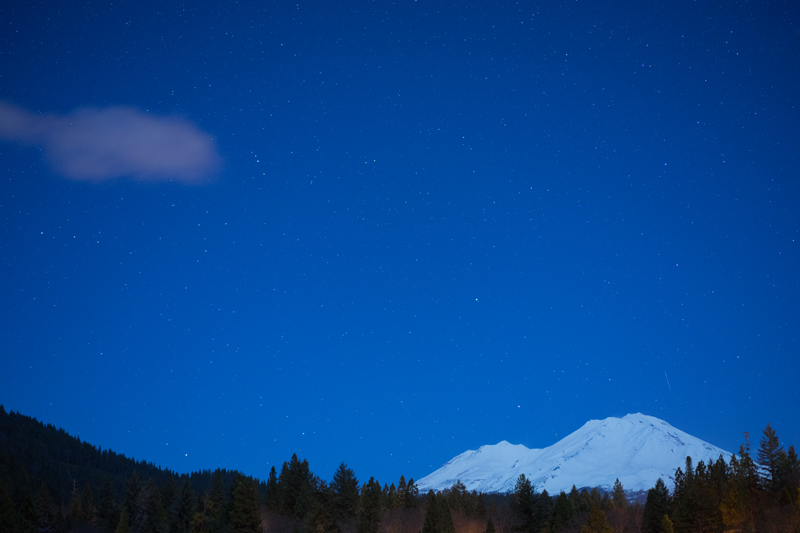
Sony A7, Sony Zeiss 55mm f/1.8 @ 10" f/1.8 ISO 3200
A quick note on each lens. The Nikkor 50mm f/1.2 AIS is a manual focus lens that has been in production for over thirty years and retails at $700. It's beautifully built to the highest classic Nikkor quality and has a standard of the era 52mm filter size. It holds a reputation as Nikon's sharpest 50mm lens at f/2 and is currently their fastest lens in production. Like all fast lenses of its age, images have a "glow" wide open with notable loss of contrast. Although lighter than the Sigma at 13oz, the all metal build makes it feel like it could last forever. I picked mine up used in beautiful condition for $450.
The Sigma 50mm f/1.4 EX DG HSM is a new lens on the market retailing at $450. Build quality is standard for a modern high end Sigma, it's nice but doesn't offer anywhere near the tactile and visual appeal of the old Nikkor. It's also heavier at 18oz and uses a 77mm front filter. The large filter size might be an issue for people new to photography, but it is the standard for all high end Nikkor f/2.8 zooms, which in reality makes filter sharing more realistic than the Nikkor for most modern photographers. As you can guess the 77mm diameter makes the lens big, and this lens is well suited for a FX camera and will feel big on DX models. Sigma was obviously shooting for the higher end here when they produced this lens because at the time of release it was more expensive than any 50mm f/1.4 Nikkor, though now it's matched in price by the latest AF-S G version. It's also worth noting the Sigma is more of a 45mm than a true 50mm focal length.
Researching these two lenses I came across some interesting opinions. F-stops are just a mathematical equation of what the light transmission of a lens should be. T-stops are the actual measured transmission values. I saw many claims that the Sigma f/1.4 actually allowed in more light at f/1.4 than the Nikkor at f/1.2. According to some, the digital sensor does not react to light coming in at an angle as well as film, making fast lenses less fast in reality on a digital sensor. Also according to some, because of this problem, a digital camera will actually increase the ISO behind the scenes so that the old fast lenses expose and meter like they should. So that raises the question of how do we test the actual t-stop of a lens without complicated equipment? Simple enough in my case, try both lenses on the Sony NEX-7 because it will shoot with no idea what lens is attached and therefore has no reason to change the ISO. In tests on the NEX-7, the Nikkor 50mm f/1.2 shows an imperceptible difference between f/1.2 and f/1.4. At either aperture it lets in slightly more light at than the Sigma f/1.4 but has notably lower contrast. On the other hand, mounted on the D700 at night the Sigma f/1.4 produced brighter images, perhaps confirming the ISO boost behind the scenes theory, or just a different sensor to lens response. I'd also guess that with the 77mm front filter is has a lot less vignetting.
All shot on a tripod with
the same
long exposure technique, identical
post processing and white balance.


Let's get right to it, 100% crops from the center at f/1.4, ten second exposure at ISO 3200 on a Nikon D700

Crop from the right edge at at f/1.4

Centers at f/2, ten second exposure at ISO 6400 on a Nikon D700

Sides of the images at f/2

In summery, the Nikkor
seems ever so slightly sharper in the center at f/1.4 and f/2, but the
Sigma has considerably less coma and vignetting while keeping a higher
degree of sharpness to the edge of the image. For night skies, I'll
take less coma over absolute sharpness. The Nikkor does get a thumbs up
for build quality and being a physically attractive lens. Perhaps the
largest surprise is that despite thirty years of age, not that much is
different in the
performance of these lenses. It's amazing considering that the Nikkor
50mm f/1.2 was designed without the help of computers.
A larger size difference than performance would indicate.


For the curious, yes the 50mm f/1.2 looks pretty bad wide open shooting stars. Even more coma than the 28mm f/2.

Nikon D700, Nikkor 50mm f/1.2 Ai-s @ 10" f/1.2 ISO 3200
2014 Update

Sony A7, Sony Zeiss 55mm f/1.8 @ 10" f/1.8 ISO 3200
2014 Update: Nikon now has
a more affordable but still expensive 58mm
f/1.4G AF-S that retails for $1,700, there is an updated Sigma 50mm
f/1.4 ART at $1,000 as well as Zeiss with the $4,000 55mm
f/1.4 Otus which should be perfect for this. I'd love to try these and
the Noct Nikkor but don't really have the money or as much interest as
I switched fully to Sony gear in the fall of 2013. Also of interest
then is the new somewhat affordable for a high end ~50mm; Sony Zeiss
55mm f/1.8, a $1,000 lens that reviews well
and is reported to have a t-stop very close to its f-stop and little
coma. What a time
for 50mm lenses, it seems like they took a thirty year break in notable
development and are back with a storm.
The Nikon nights had the milky way and
no moon, while the Sony Zeiss 55mm shots had the moon in play. Still
the lack of coma shows the Sony Zeiss as far superior for
night star images vs the Nikon 50mm f/1.2 or Sigma 50mm f/1.4. Resized
to 12mp to match the
D700 crops.

